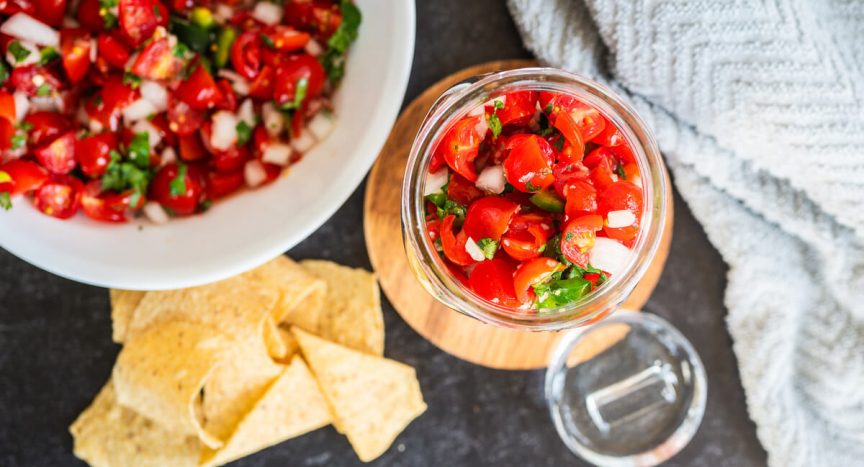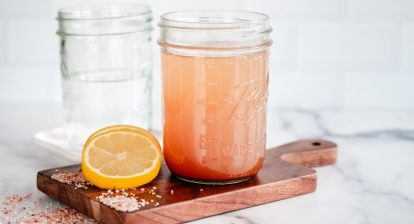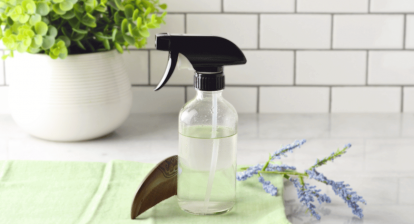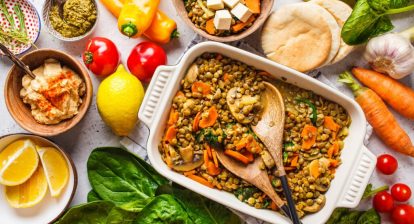Now that we're on the cusp of tomato and pepper season, I wanted to share this fermented salsa recipe. Fermenting fresh salsa is an easy way to make it last longer without canning and adds a probiotic boost. Try it on tacos or with some homemade tortilla chips!
We eat and drink a lot of fermented foods, from water kefir sour, to sauerkraut. Fermented salsa is definitely one of the easiest ways to get it health benefits of fermented foods in your diet. The fermentation process creates good bacteria that help improve gut health and the immune system.
If done right, fermented salsa will last for months in the fridge or freezer and will pick up more probiotics as it ages. This spicy Mexican condiment is a staple in our house!
Salsa Ingredients and Substitutions
While I like a little kick in my salsa, you can make this as mild or spicy as you like. For a mild version (especially for kids who don't like spicy) use bell peppers. I will often grab whatever is ripe in our garden. You can also add jalapeno peppers, habanero peppers, or a mix of whatever you like.
However, the fresh tomatoes are what make this recipe so good. If you don't have any growing in your garden, then check out your local farmers market. Home grown and local is so much better than what is available in most grocery stores!
I also included different spices in the recipe, but I don't use exact amounts. Feel free to use whatever spices your family likes. Or keep it simple and remove them altogether.
Method of fermenting whey against salt
I usually make this with leftover whey from making homemade yogurt cheese. This lacto-fermented version contains beneficial bacteria from the lactic acid in the yogurt, but is optional. You'll still get probiotic benefits just from using salt. Fermenting the salsa also extends the shelf life.
If you don't have whey from strained yogurt, you can use a little whey instead. Cultures for Health it's a great place to get some.
Tip for fermenting salsa
If this is your first time fermenting vegetables, there are a few things you should know before you get started. Be sure to use a completely clean jar, lid, and equipment when doing this. You don't want to introduce any bad competing bacteria into your salsa!
Once everything is chopped and mixed, it will keep on the counter at room temperature for about 2 days. If your house is warmer (hello summer!), this process won't take as long. You want to watch for little fizzy bubbles that will tell you the salsa is ready.
You don't need any fancy equipment, but I prefer to use a fermenting weight for this. Keeps vegetables under liquid so they don't start to mold. If your salsa gets really fizzy, you may need to “crack” your mason jar. Just remove the cap to let some of the excess gas out and then put it back on. Some people prefer to use an airlock or fermentation lid for this (to prevent jar explosions!).
How to use fermented salsa
You probably already have tons of foods your family loves with salsa, but here are some of my favorite ways to use it up!
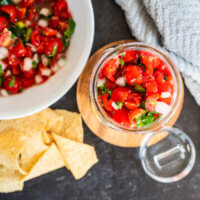
Fermented salsa recipe
Homemade salsa with a probiotic twist; naturally fermented to add extra nutrients and flavor.
- 3 £ fresh tomatoes (about 4 and 1/2 cups chopped)
- 2 PEPPERS (such as bell peppers, cayenne, or jalapeno peppers)
- 1-2 onions (about 1 cup chopped)
- 4 carnation garlic
- ½ CUP fresh cilantro
- 1 lemon (liquid)
- 1 Lime (liquid)
- 2 TBSP sea salt
- spices to taste (such as oregano, black pepper, cumin, chili powder, and cayenne)
- ½ CUP whey (optional)
-
Chop the tomatoes, onion, pepper, garlic and cilantro and add to a large bowl.
-
Add lemon and lime juice, sea salt and spices to taste.
-
Add buttermilk (if using) and mix well.
-
Transfer the diced vegetable mixture to a tall mason jar/fermenting jar. Discard any liquid from the bowl.
-
Press down to submerge the vegetables and place a weight on top to keep them submerged.
-
Close the top of the jar and let it ferment for about 2 days out of direct sunlight. It will get gassy and start to get little bubbles.
-
After 2 days, remove the fermentation weight and enjoy or refrigerate.
Nutrition facts
Fermented salsa recipe
Amount per serving (1 serving)
Calories 18
Calories from fat 2
% Daily Value*
Fat 0.2 g0%
Saturated fat 0.03 g0%
Unsaturated fat 0.1 g
Monounsaturated fat 0.02 g
Sodium 562 mg24%
potassium 171 mg5%
Carbohydrates 4 g1%
Fiber 1 g4%
Sugar 2 g2%
Protein 1 g2%
Vitamin A 513 IU10%
Vitamin C 19 mg23%
Calcium 12 mg1%
Iron 0.3 mg2%
* Percent Daily Values are based on a 2000 calorie diet.
- If you want a less chunky salsa then you may want to put it in a food processor before moving it to a mason jar/fermenting jar.
- The exact fermentation time depends on how warm your house is. Fermented vegetables ferment faster in warm weather.
- A serving size is about 1/4 cup.
A quick and easy tip
If you don't have the time or ingredients to make your own salsa, you can reap the benefits of fermented salsa by fermenting store-bought salsa as well. If possible, use the freshly made sauces in the refrigerated section, but you can also ferment the canned versions.
More fermented food recipes
Want to try your hand at more fermented foods? Here are some ideas to get you started!
Have you ever fermented vegetables before? What's your favorite way to use salsa? Leave a comment and let us know!

